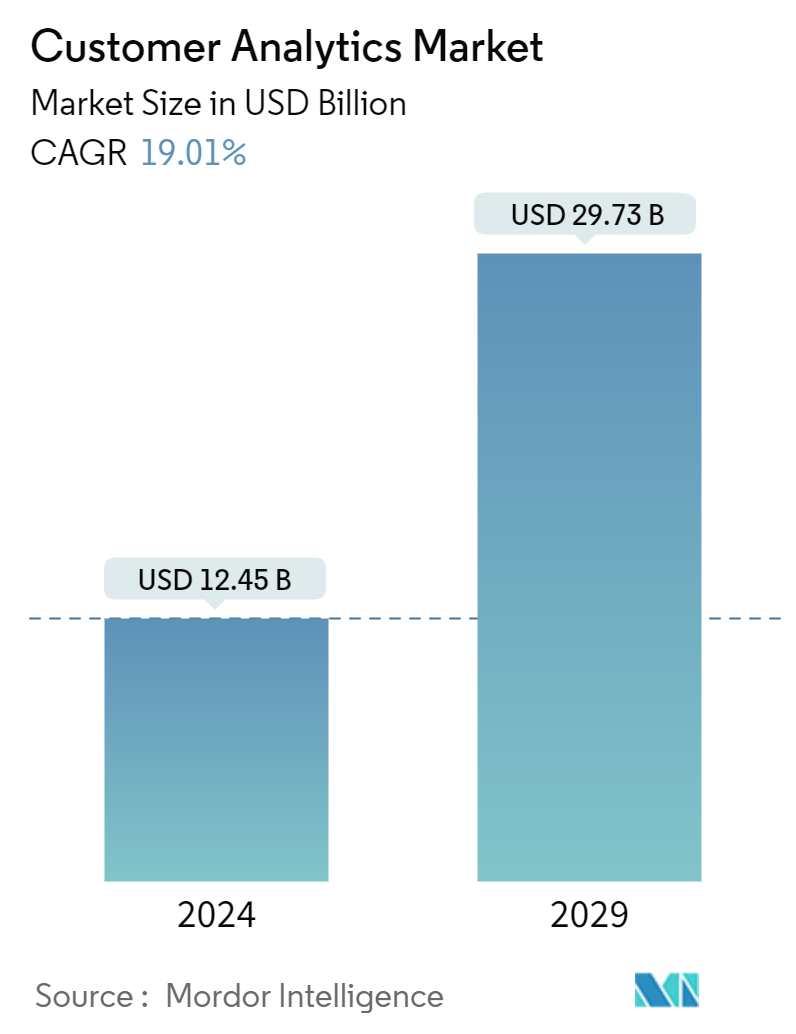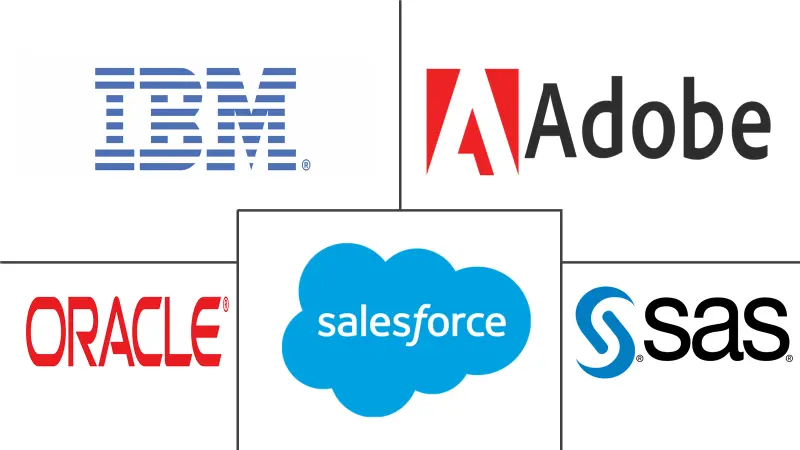Market Size of Customer Analytics Industry

| Study Period | 2019 - 2029 |
| Market Size (2024) | USD 12.45 Billion |
| Market Size (2029) | USD 29.73 Billion |
| CAGR (2024 - 2029) | 19.01 % |
| Fastest Growing Market | Asia Pacific |
| Largest Market | North America |
| Market Concentration | Low |
Major Players
*Disclaimer: Major Players sorted in no particular order |
Customer Analytics Market Analysis
The Customer Analytics Market size is estimated at USD 12.45 billion in 2024, and is expected to reach USD 29.73 billion by 2029, growing at a CAGR of 19.01% during the forecast period (2024-2029).
Due to the variety of cloud-based solutions already on the market, more businesses are expected to migrate to the cloud. Companies might also learn how to exploit the potential of cloud analytics, where the bulk of the components, such as customer data sources, data models, processing apps, computing capacity, analytic models, and data storage, are hosted. This might assist in incorporating intelligence into existing procedures and improve operational decision-making.
- Other factors driving the growth of the customer analytics market include the need to understand customer purchasing behavior to provide a more personalized customer experience, in addition to the advancement of technology such as artificial intelligence (AI), machine learning (ML), and business process automation to streamline marketing processes.
- The industry under consideration is rapidly developing due to the rising need for greater customer pleasure. Customer analytics are used in retail to produce tailored communications and marketing strategies. They know which consumers buy what, and tailoring marketing to them based on shopper data may increase customer experience and loyalty. According to the ACSI Retail and Consumer Study, retailers may sigh relief as consumer satisfaction remains relatively stable in the previous year due to a great shopping experience via repeat purchases, customer loyalty, customer referrals, revenues, and participation.
- Another element propelling the industry is the rise in social media awareness. Social media analytics enhances the benefits of social networking by increasing brand exposure, increasing brand value, and expanding consumer reach through social media platforms by linking their product list with e-commerce sites, which assists in monitoring people and connection development. Amazon and Walmart have utilized social media sites such as Facebook, Instagram, YouTube, and Twitter to promote their items. Social platforms are modern-day shops that act as a conduit between customers and entities.
- In recent years, there has been a rise in security and privacy breaches. As a result, customers began to worry more about their privacy and security. This has been a critical impediment to the expansion of the customer analytics sector. Significant data architecture in consumer analytics may become increasingly crucial to safeguard, threatening data loss.
Customer Analytics Industry Segmentation
The consumer analytics market is gaining traction as more firms migrate from on-premise to cloud-based services to promote company development. Client analytics are being utilized by insurance firms, banks, and many other businesses to analyze client lifetime value better and increase cross-selling, among other things. In contrast to telecom, which focuses on reducing churn, industries such as e-commerce and retail strongly emphasize client purchase behavior.
The Customer analytics market is segmented by deployment type (on-premise and cloud-based), solution (social media analytical tools, web analytical tools, dashboard and reporting tools, voice of customer, ETL, and analytical modules/tools), organization size (small and medium enterprises and large enterprises), service (managed service and professional service), end-user industry (telecommunications and IT, travel and hospitality, and retail), and geography.
| By Deployment Type | |
| On-premise | |
| Cloud-based |
| By Solution | |
| Social Media Analytical Tools | |
| Web Analytical Tools | |
| Dashboard and Reporting Tools | |
| Voice of Customer (VOC) | |
| ETL (Extract, Transform, and Load) | |
| Analytical Modules/Tools |
| By Organization Size | |
| Small and Medium Enterprises | |
| Large Enterprises |
| By Service | |
| Managed Service | |
| Professional Service |
| By End-user Industry | |
| Telecommunications and IT | |
| Travel and Hospitality | |
| Retail | |
| BFSI | |
| Media and Entertainment | |
| Healthcare | |
| Transportation and Logistics | |
| Manufacturing | |
| Other End-user Industries |
| By Geography*** | |
| North America | |
| Europe | |
| Asia | |
| Australia and New Zealand | |
| Latin America | |
| Middle East and Africa |
Customer Analytics Market Size Summary
The customer analytics market is experiencing significant growth, driven by the increasing adoption of cloud-based solutions and advancements in technologies such as artificial intelligence and machine learning. Businesses are leveraging these technologies to gain deeper insights into customer purchasing behavior, enabling them to deliver personalized experiences and improve operational decision-making. The retail sector, in particular, is utilizing customer analytics to enhance customer satisfaction through tailored communications and marketing strategies. The rise of e-commerce and social media has further amplified the need for customer analytics, as companies seek to expand their reach and strengthen brand presence across digital platforms.
North America is poised to maintain a dominant position in the customer analytics market, supported by a strong presence of key industry players and a growing demand for big data projects. The market is characterized by intense competition, with established companies like Adobe, IBM, and Oracle investing in research and development to innovate and capture market share. Recent developments include the introduction of new tools and platforms that integrate customer data across various channels, enabling businesses to create more personalized and engaging customer experiences. Despite challenges such as privacy concerns and data security, the market continues to expand as organizations recognize the value of data-driven insights in enhancing customer loyalty and driving revenue growth.
Customer Analytics Market Size - Table of Contents
-
1. MARKET DYNAMICS
-
1.1 Market Overview
-
1.2 Introduction to Market Drivers and Restraints
-
1.3 Market Drivers
-
1.3.1 Rising Demand for Improved Customer Satisfaction
-
1.3.2 Increase in Social Media Concern to Address Customer Behavior
-
-
1.4 Market Restraints
-
1.4.1 Data Security and Privacy Concerns
-
-
1.5 Value Chain Analysis
-
1.6 Industry Attractiveness - Porter's Five Forces Analysis
-
1.6.1 Threat of New Entrants
-
1.6.2 Bargaining Power of Buyers/Consumers
-
1.6.3 Bargaining Power of Suppliers
-
1.6.4 Threat of Substitute Products
-
1.6.5 Intensity of Competitive Rivalry
-
-
-
2. MARKET SEGMENTATION
-
2.1 By Deployment Type
-
2.1.1 On-premise
-
2.1.2 Cloud-based
-
-
2.2 By Solution
-
2.2.1 Social Media Analytical Tools
-
2.2.2 Web Analytical Tools
-
2.2.3 Dashboard and Reporting Tools
-
2.2.4 Voice of Customer (VOC)
-
2.2.5 ETL (Extract, Transform, and Load)
-
2.2.6 Analytical Modules/Tools
-
-
2.3 By Organization Size
-
2.3.1 Small and Medium Enterprises
-
2.3.2 Large Enterprises
-
-
2.4 By Service
-
2.4.1 Managed Service
-
2.4.2 Professional Service
-
-
2.5 By End-user Industry
-
2.5.1 Telecommunications and IT
-
2.5.2 Travel and Hospitality
-
2.5.3 Retail
-
2.5.4 BFSI
-
2.5.5 Media and Entertainment
-
2.5.6 Healthcare
-
2.5.7 Transportation and Logistics
-
2.5.8 Manufacturing
-
2.5.9 Other End-user Industries
-
-
2.6 By Geography***
-
2.6.1 North America
-
2.6.2 Europe
-
2.6.3 Asia
-
2.6.4 Australia and New Zealand
-
2.6.5 Latin America
-
2.6.6 Middle East and Africa
-
-
Customer Analytics Market Size FAQs
How big is the Customer Analytics Market?
The Customer Analytics Market size is expected to reach USD 12.45 billion in 2024 and grow at a CAGR of 19.01% to reach USD 29.73 billion by 2029.
What is the current Customer Analytics Market size?
In 2024, the Customer Analytics Market size is expected to reach USD 12.45 billion.

